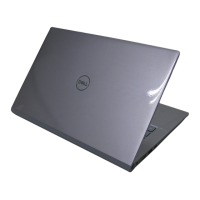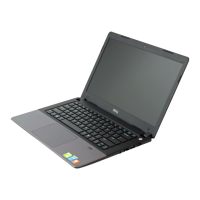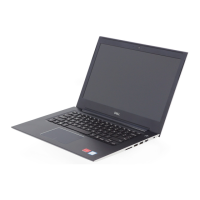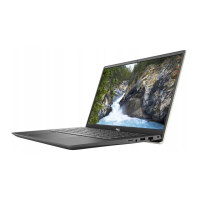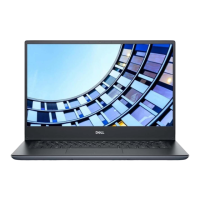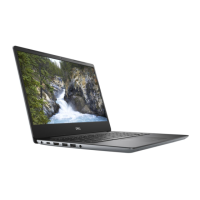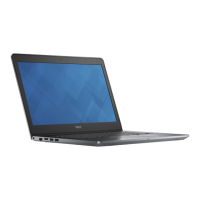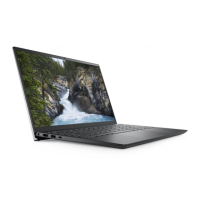Do you have a question about the Dell Vostro 5460 and is the answer not in the manual?
Guidelines to protect your computer and ensure personal safety before performing any internal procedure.
Procedure to safely shut down the operating system and power off the computer before working inside.
Steps to reconnect devices and power on the computer after completing internal work.
Lists essential tools required for component removal and installation procedures.
Provides an illustration of internal components after the base cover removal.
Step-by-step instructions for removing the computer's base cover.
Instructions for properly aligning and securing the computer's base cover.
Procedure for disconnecting and removing the notebook battery from the computer.
Steps for placing and securing the battery, connecting its cable, and reassembling.
Instructions for disconnecting and removing the computer's hard disk drive assembly.
Procedure for installing the hard drive assembly and reassembling components.
Steps to disconnect and remove the coin-cell battery from the system board.
Procedure for placing, routing, and connecting the coin-cell battery.
Instructions for disconnecting antennae and removing the WLAN card.
Steps for inserting, securing, and connecting the WLAN card and antennae.
Procedure to remove the screw and then the mSATA card from its slot.
Steps for inserting and securing the mSATA card into its slot.
Instructions to disconnect cables and remove screws for the system fan.
Procedure for placing, securing, and connecting the system fan and flex cable.
Steps to remove components and screws to detach the heat sink.
Procedure for placing, securing the heat sink, and reassembling components.
Instructions to pry clips and remove the memory module from its socket.
Steps for inserting and pressing the memory module into its socket.
Procedure to disconnect cables and remove screws securing the system board.
Steps for placing, securing the system board, and reconnecting cables.
Instructions to disengage tabs and remove speaker assemblies from the chassis.
Procedure for placing, routing, and connecting speaker connectors to the system board.
Steps to disconnect display and camera cables and remove the assembly.
Procedure for aligning, securing hinges, and connecting display/camera cables.
Instructions to rotate hinges and pry off plastic caps to access bezel screws.
Steps for aligning, securing the display bezel with screws, and installing caps.
Instructions to remove the display bezel and then remove screws securing the display.
Procedure for aligning the display, installing screws, and reassembling components.
Steps to disconnect the camera cable and lift the camera to remove it.
Procedure for aligning the camera, connecting its cable, and reassembling.
Overview of System Setup functionality for hardware and system configuration.
Guide to altering the boot order and using the one-time boot menu.
Reference for keys used to navigate and interact within the System Setup utility.
Recommended procedure for updating the BIOS for improved system stability and features.
Details 'Main' and 'Advanced' System Setup options and their functionalities.
Procedure for running pre-boot diagnostics to identify hardware problems.
Explanation of battery charge LED behavior in different operational states.
Interpretation of device status lights for power, activity, and battery status.
List of LED error codes and their associated fault conditions and troubleshooting steps.
Compilation of technical details for system, processor, memory, and audio components.
Instructions for accessing support resources and information on the Dell website.
| Form factor | Clamshell |
|---|---|
| Product type | Laptop |
| Product color | Graphite, Silver |
| Bus type | DMI |
| Stepping | L1 |
| Tjunction | 90 °C |
| Processor cache | 3 MB |
| Processor cores | 2 |
| System bus rate | 5 GT/s |
| Processor family | Intel® Core™ i3 |
| Processor series | Intel Core i3-3100 Mobile Series |
| Processor socket | BGA 1023 |
| Processor threads | 4 |
| Processor codename | Ivy Bridge |
| Processor frequency | 2.4 GHz |
| Processor cache type | Smart Cache |
| Processor lithography | 22 nm |
| Processor manufacturer | Intel |
| Processor front side bus | - MHz |
| PCI Express slots version | 2.0 |
| Processor operating modes | 64-bit |
| ECC supported by processor | No |
| PCI Express configurations | 1x16, 2x8, 1x8+2x4 |
| Thermal Design Power (TDP) | 35 W |
| CPU multiplier (bus/core ratio) | 24 |
| Maximum number of PCI Express lanes | 16 |
| Motherboard chipset | Intel HM77 Express |
| Internal memory | 2 GB |
| Memory clock speed | 1600 MHz |
| Internal memory type | DDR3-SDRAM |
| Maximum internal memory | - GB |
| HDD speed | 5400 RPM |
| HDD interface | SATA |
| Storage media | HDD |
| Card reader integrated | Yes |
| Total storage capacity | 500 GB |
| Number of HDDs installed | 1 |
| Pixel pitch | 0.2265 x 0.2265 mm |
| Display surface | - |
| Display diagonal | 14 \ |
| Display brightness | 200 cd/m² |
| Display resolution | 1366 x 768 pixels |
| Native aspect ratio | 16:9 |
| On-board graphics card ID | 0x166 |
| Discrete graphics card model | Not available |
| On-board graphics card model | Intel® HD Graphics 4000 |
| On-board graphics card family | Intel® HD Graphics |
| On-board graphics card base frequency | 650 MHz |
| On-board graphics card dynamic frequency (max) | 1000 MHz |
| Audio system | WaveMaxx Audio |
| Speaker power | 1.5 W |
| Speakers manufacturer | Waves |
| Front camera resolution | 1280 x 720 pixels |
| Front camera resolution (numeric) | 1 MP |
| Wi-Fi standards | 802.11a, 802.11b, 802.11g |
| Bluetooth version | 4.0 |
| Ethernet LAN data rates | 10, 100, 1000 Mbit/s |
| Charging port type | DC-in jack |
| USB 2.0 ports quantity | USB 2.0 ports have a data transmission speed of 480 Mbps, and are backwards compatible with USB 1.1 ports. You can connect all kinds of peripheral devices to them. |
| eSATA/USB 2.0 ports quantity | 0 |
| Pointing device | Touchpad |
| Operating system installed | FreeDOS |
| Processor code | SR0N2 |
| Processor ARK ID | 65700 |
| Processor package size | 37.5 x 37.5 (rPGA988B); 31 x 24 (BGA1023) mm |
| Supported instruction sets | AVX |
| Intel Identity Protection Technology version | 1.00 |
| Battery voltage | 11.4 V |
| Battery life (max) | - h |
| Number of battery cells | 3 |
| AC adapter power | 65 W |
| AC adapter frequency | 50 - 60 Hz |
| AC adapter input voltage | 100 - 240 V |
| Cables included | AC |
| Operating altitude | -15.2 - 3048 m |
| Non-operating altitude | -15.2 - 10668 m |
| Storage temperature (T-T) | -20 - 60 °C |
| Operating temperature (T-T) | 0 - 40 °C |
| Storage relative humidity (H-H) | 20 - 95 % |
| Operating relative humidity (H-H) | 20 - 90 % |
| Sustainability certificates | EPEAT Silver, ENERGY STAR |
| Depth | 233.5 mm |
|---|---|
| Width | 337.6 mm |
| Weight | 1540 g |
| Height (rear) | 21 mm |
| Height (front) | 18.3 mm |

